-


by W H Fitch from John Eliot Howard’s
‘The Quinology of the East Indian Plantations’
original hand coloured lithograph
The tree bark of the Cinchona tree contains quinine, an alkaloid used to treat malaria. Malaria was a major health concern for the colonial administration in India and the first cinchona plantation was established in 1860 in the Nilgiri Hills due to its suitable climate and soil. Over the next few years, several other plantations were established in the region, including at Coonoor, Kotagiri, and Ooty. By the early 20th century, the Indian cinchona plantations had become one of the largest producers of quinine in the world, supplying not only India but also other parts of the British Empire.
‘The Quinology of the East Indian Plantations’ by John Eliot Howard (1807-1883) is a continuation of Benjamin Moseley’s earlier book on the same subject, and provides an updated account of the cultivation and use of quinine in the East Indian plantations during the 19th century and its introduction into India. Howard’s book includes detailed descriptions of the different species of cinchona trees, as well as the various methods used to extract and prepare quinine. He also discusses the economic and political implications of the quinine trade, which had become a major industry in the region by the mid-19th century. Howard received the thanks of Her Majesty’s Government in 1873 for The Quinology of the East Indian Plantations.
Framed Size (cms): 65(H) x 54(W)
Framed Size (inches): 25.5(H) x 21.5(W)
Print Size (cms): 45.75(H) x 34.25(W)
Print Size (inches): 18(H) x 13.5(W)
-


by W H Fitch from John Eliot Howard’s
‘The Quinology of the East Indian Plantations’
original hand coloured lithograph
The tree bark of the Cinchona tree contains quinine, an alkaloid used to treat malaria. Malaria was a major health concern for the colonial administration in India and the first cinchona plantation was established in 1860 in the Nilgiri Hills due to its suitable climate and soil. Over the next few years, several other plantations were established in the region, including at Coonoor, Kotagiri, and Ooty. By the early 20th century, the Indian cinchona plantations had become one of the largest producers of quinine in the world, supplying not only India but also other parts of the British Empire.
‘The Quinology of the East Indian Plantations’ by John Eliot Howard (1807-1883) is a continuation of Benjamin Moseley’s earlier book on the same subject, and provides an updated account of the cultivation and use of quinine in the East Indian plantations during the 19th century and its introduction into India. Howard’s book includes detailed descriptions of the different species of cinchona trees, as well as the various methods used to extract and prepare quinine. He also discusses the economic and political implications of the quinine trade, which had become a major industry in the region by the mid-19th century. Howard received the thanks of Her Majesty’s Government in 1873 for The Quinology of the East Indian Plantations.
Framed Size (cms): 65(H) x 54(W)
Framed Size (inches): 25.5(H) x 21.5(W)
Print Size (cms): 45.75(H) x 34.25(W)
Print Size (inches): 18(H) x 13.5(W)
-
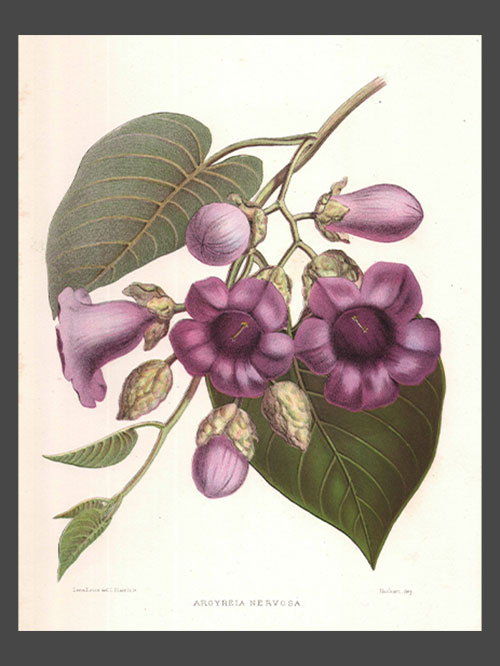
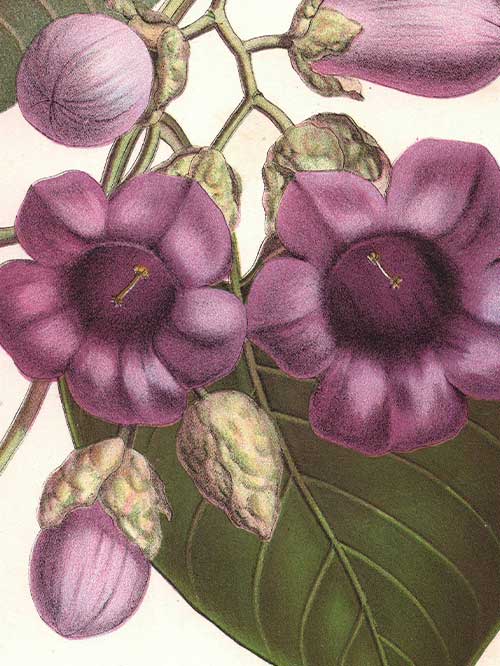
by Lena Lowis
original hand coloured lithograph
Captioned ‘Argyreia nervosa’
Lena Lowis (1845- 1919) was the daughter of Sir Richmond Campbell Shakespear (1812-1861), an Indian-born British Indian Army officer who helped abolish the capture and selling of Russian slaves in Khiva. She was born in India and later educated and married in England where she lived with her husband and five children.
The artist chronicled many of the flowers commonly cultivated in Indian gardens, some of which were indigenous to the region, while others were introduced by gardeners. Her illustrations are not meant to be taken treatise on botany or as a manual of gardening, rather to convey a fair idea of the colour and texture of the original, to those who have not seen them.
Size (cms): 25.5(H) x 20(W)
Size (inches): 10(H) x 8(W)
Size with Mount (cms): 42(H) x 36(W)
Size with Mount (inches): 16.5(H) x 14(W)
-
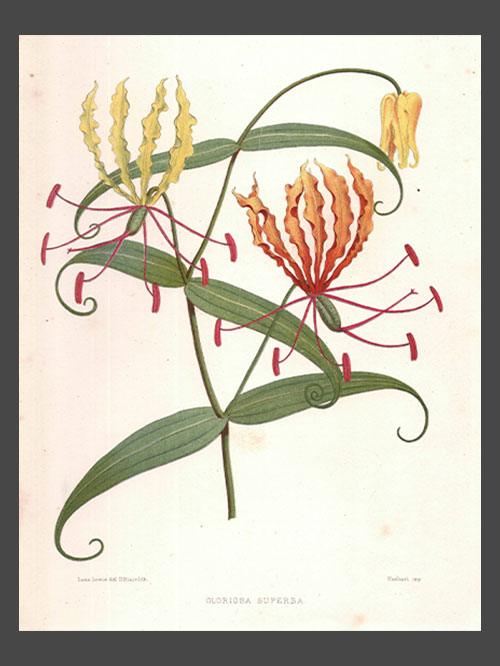

by Lena Lowis
original hand coloured lithograph
Captioned ‘Gloriosa superba’
Lena Lowis (1845- 1919) was the daughter of Sir Richmond Campbell Shakespear (1812-1861), an Indian-born British Indian Army officer who helped abolish the capture and selling of Russian slaves in Khiva. She was born in India and later educated and married in England where she lived with her husband and five children.
The artist chronicled many of the flowers commonly cultivated in Indian gardens, some of which were indigenous to the region, while others were introduced by gardeners. Her illustrations are not meant to be taken treatise on botany or as a manual of gardening, rather to convey a fair idea of the colour and texture of the original, to those who have not seen them.
Size (cms): 25.5(H) x 20(W)
Size (inches): 10(H) x 8(W)
Size with Mount (cms): 42(H) x 36(W)
Size with Mount (inches): 16.5(H) x 14(W)
-

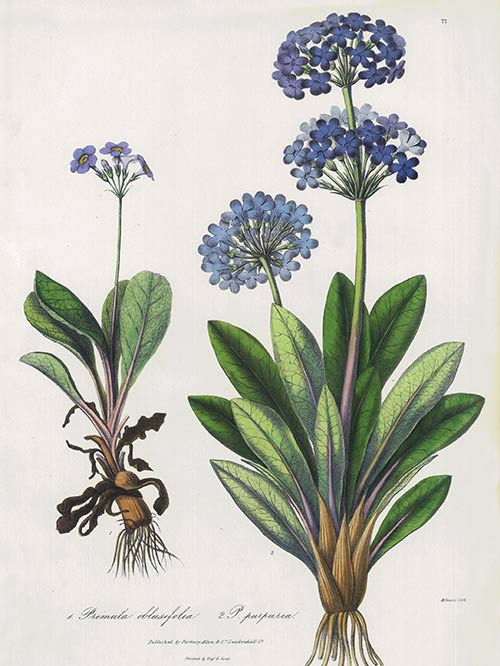
by John Forbes Royle (1798-1858)
Original hand-coloured lithograph
Pub. London
This decorative botanical lithograph depicts two flowering plants, the Primula obtusifolia, commonly known as “Blunt-leaved Primrose,” and the Primula purpurea, commonly known as Purple Himalayan Primrose.” Both are native to the Himalayan region, particularly found in parts of India, Nepal, Bhutan, and Tibet. They grow in alpine meadows and rocky slopes, thriving in cooler, mountainous climates. It is often cultivated as an ornamental plant for its charming flowers and attractive foliage.
John Forbes Royle was a prominent British botanist, physician, and pharmacologist during the 19th century. Royle received his medical education at St. Thomas’s Hospital in London and later served as a surgeon in the British East India Company’s army. During his time in India, Royle became deeply interested in the country’s flora and medicinal plants. He collected a vast number of plant specimens and meticulously documented their medicinal properties. One of Royle’s most notable works was the ‘‘Illustrations of the botany and other branches of the natural history of the Himalayan Mountains and of the flora of Cashmere’. This comprehensive work provided detailed descriptions and illustrations of numerous plant species found in the Himalayan region. It remains an important reference for botanical research in the area.
Image Size (cms): 36.5(H) x 26(W)
Image Size (inches): 14.5(H) x 10(W)
Mount Size (cms): 51(H) x 41(W)
Mount Size (inches): 20(H) x 16(W)
-
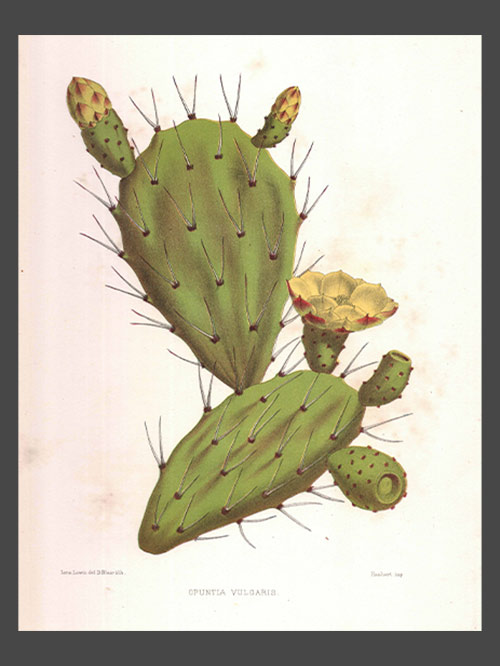
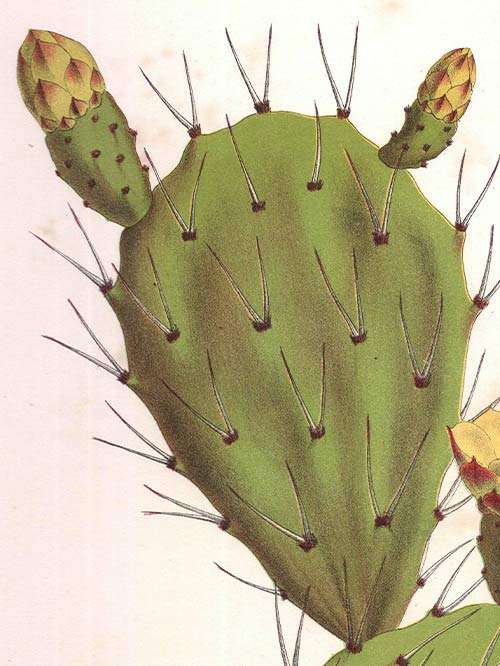
by Lena Lowis
original hand coloured lithograph
Captioned ‘Opuntia vulgaris’
Lena Lowis (1845- 1919) was the daughter of Sir Richmond Campbell Shakespear (1812-1861), an Indian-born British Indian Army officer who helped abolish the capture and selling of Russian slaves in Khiva. She was born in India and later educated and married in England where she lived with her husband and five children.
The artist chronicled many of the flowers commonly cultivated in Indian gardens, some of which were indigenous to the region, while others were introduced by gardeners. Her illustrations are not meant to be taken treatise on botany or as a manual of gardening, rather to convey a fair idea of the colour and texture of the original, to those who have not seen them.
Size (cms): 25.5(H) x 20(W)
Size (inches): 10(H) x 8(W)
Size with Mount (cms): 42(H) x 36(W)
Size with Mount (inches): 16.5(H) x 14(W)
-
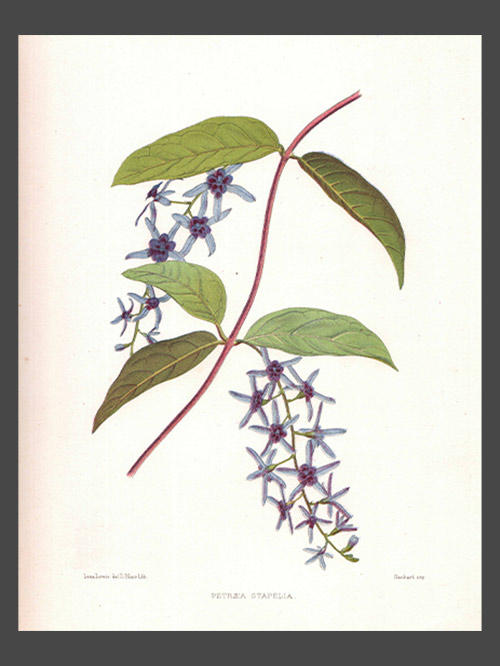
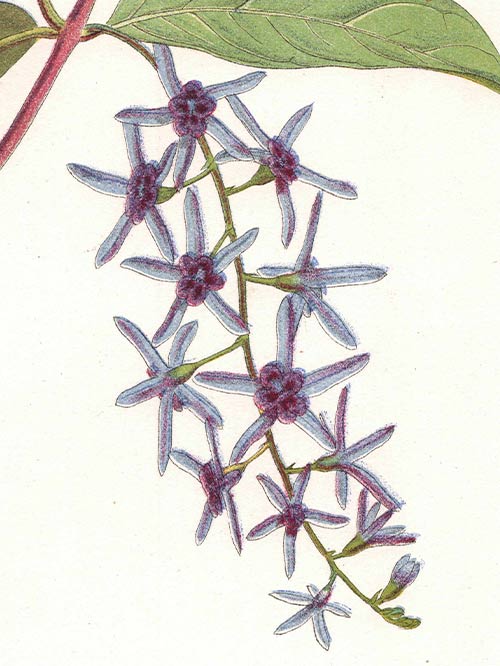
by Lena Lowis
original hand coloured lithograph
Captioned ‘Petrea stapeliae’
Lena Lowis (1845- 1919) was the daughter of Sir Richmond Campbell Shakespear (1812-1861), an Indian-born British Indian Army officer who helped abolish the capture and selling of Russian slaves in Khiva. She was born in India and later educated and married in England where she lived with her husband and five children.
The artist chronicled many of the flowers commonly cultivated in Indian gardens, some of which were indigenous to the region, while others were introduced by gardeners. Her illustrations are not meant to be taken treatise on botany or as a manual of gardening, rather to convey a fair idea of the colour and texture of the original, to those who have not seen them.
Size (cms): 25.5(H) x 20(W)
Size (inches): 10(H) x 8(W)
Size with Mount (cms): 42(H) x 36(W)
Size with Mount (inches): 16.5(H) x 14(W)
-
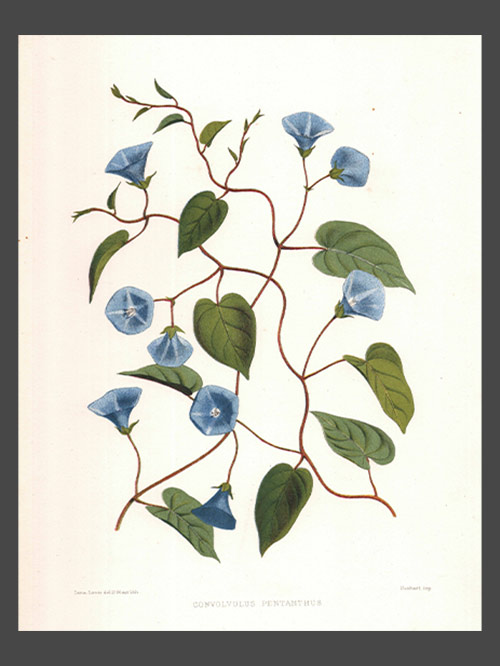
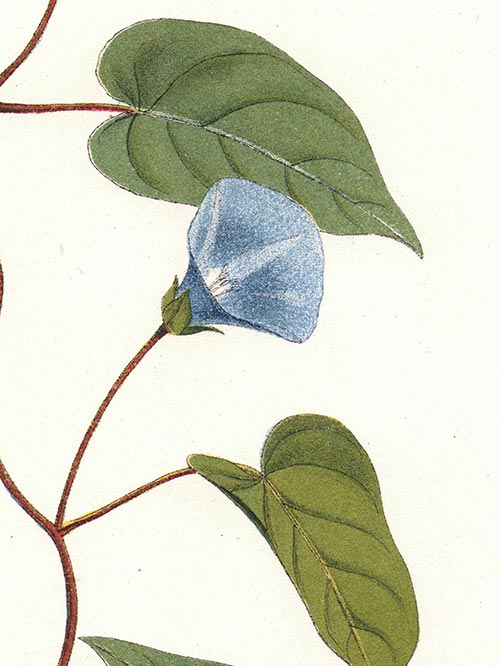
by Lena Lowis
original hand coloured lithograph
Captioned ‘Convolvulus pentanthus’
Lena Lowis (1845- 1919) was the daughter of Sir Richmond Campbell Shakespear (1812-1861), an Indian-born British Indian Army officer who helped abolish the capture and selling of Russian slaves in Khiva. She was born in India and later educated and married in England where she lived with her husband and five children.
The artist chronicled many of the flowers commonly cultivated in Indian gardens, some of which were indigenous to the region, while others were introduced by gardeners. Her illustrations are not meant to be taken treatise on botany or as a manual of gardening, rather to convey a fair idea of the colour and texture of the original, to those who have not seen them.
Size (cms): 25.5(H) x 20(W)
Size (inches): 10(H) x 8(W)
Size with Mount (cms): 42(H) x 36(W)
Size with Mount (inches): 16.5(H) x 14(W)
-


by John Forbes Royle (1798-1858)
Original hand-coloured lithograph
Pub. London
Nardostachys jatamansi, commonly known as “Spikenard” or “Jatamansi,” is a flowering plant in the Valerianaceae family. It is native to the Himalayan region, particularly found in parts of India, Nepal, Bhutan, and Tibet. This perennial herbaceous plant is characterized by its long, slender rhizomes and clusters of small, pink flowers. Spikenard has a long history of traditional medicinal use in Ayurvedic and Tibetan medicine, where it is valued for its calming and sedative properties. It is also used in perfumery and aromatherapy for its unique and earthy fragrance.
John Forbes Royle was a prominent British botanist, physician, and pharmacologist during the 19th century. Royle received his medical education at St. Thomas’s Hospital in London and later served as a surgeon in the British East India Company’s army. During his time in India, Royle became deeply interested in the country’s flora and medicinal plants. He collected a vast number of plant specimens and meticulously documented their medicinal properties. One of Royle’s most notable works was the ‘‘Illustrations of the botany and other branches of the natural history of the Himalayan Mountains and of the flora of Cashmere’. This comprehensive work provided detailed descriptions and illustrations of numerous plant species found in the Himalayan region. It remains an important reference for botanical research in the area.
Image Size (cms): 36.5(H) x 26(W)
Image Size (inches): 14.5(H) x 10(W)
Mount Size (cms): 51(H) x 41(W)
Mount Size (inches): 20(H) x 16(W)



















